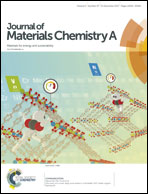Oxygen vacancies induced exciton dissociation of flexible BiOCl nanosheets for effective photocatalytic CO2 conversion†
Abstract
Layered bismuth oxychloride (BOC) exhibits highly efficient activity for photocatalytic environmental remediation due to the confinement effect induced excitonic photocatalytic process. However, the strong excitonic process suppresses catalytic reactions with photo-induced electrons, such as hydrogen generation, CO2 conversion and nitrogen fixation. Moreover, the wide band gap of BiOCl limits its application under visible light. In this study, flexible BiOCl nanosheets with oxygen vacancies (BOC-OV) were successfully prepared. Molecular oxygen activation, electronic spin resonance (ESR), transient photocurrent, transient absorption spectroscopy, and transient fluorescence spectroscopy indicated that oxygen vacancies induced exciton dissociation of flexible BiOCl nanosheets. Moreover, oxygen vacancies induced wide spectrum (UV-Vis) absorption. The enhanced exciton dissociation resulted in the superior CO2 conversion of BOC-OV under UV-Vis light irradiation, where the light to carbon monoxide (LTCO) conversion efficiency reached up to 26.5 × 10−6. Theoretical calculations and in situ Fourier transform infrared spectrometry (FT-IR) analysis revealed that the mechanism of oxygen vacancies improves the photocatalytic CO2 conversion with BOC-OV via the CO2 hydrogenation pathway. This study indicates that oxygen vacancies have a great influence on photocatalytic CO2 reduction due to their special surface and electron structure properties.



 Please wait while we load your content...
Please wait while we load your content...